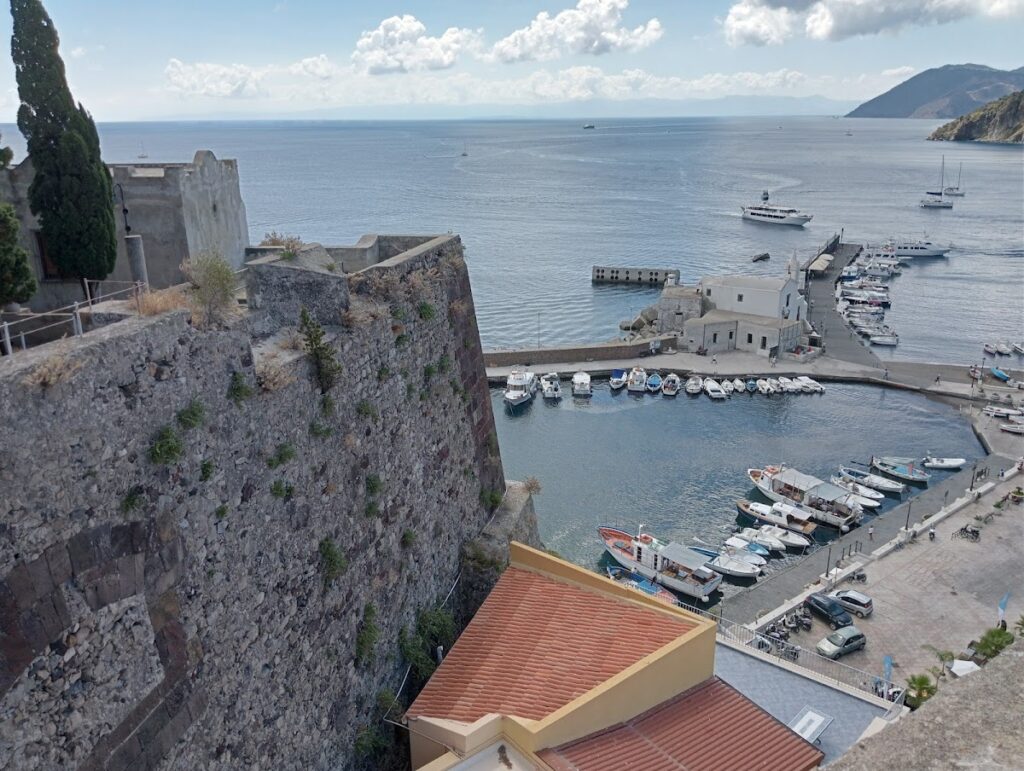Castello di Lipari: A Historic Volcanic Fortress in Italy
Visitor Information
Google Rating: 4.5
Popularity: Medium
Google Maps: View on Google Maps
Country: Italy
Civilization: Unclassified
Remains: Military
History
The Castello di Lipari occupies a prominent volcanic acropolis in the town of Lipari, Italy. This strategic location overlooking the Tyrrhenian Sea has attracted human settlement since prehistoric times, developing over millennia into a fortified stronghold shaped by successive cultures.
Archaeological evidence traces continuous human presence here from the Neolithic period, approximately 4000 BCE, when early inhabitants lived in simple, oval-shaped huts built of dry stones with roofs made from plant branches. Around 580-576 BCE, Greek settlers from Cnidus and Rhodes established a colony on the site, integrating the area into the wider Greek world of Sicily. Remnants from this era include a sturdy tower dating to the 4th century BCE and a notable structure known as the Bothros of Aeolus, both hinting at organized settlement and ritual activity.
The Roman era brought significant urban development to Lipari between the 2nd and 1st centuries BCE. The town adopted an organized street plan featuring main roads (cardines running north-south and decumani running east-west) which connected to the acropolis via an access road. The establishment of these city planning elements demonstrates Lipari’s integration into Roman administrative and military structures.
Following the Roman phase, control passed successively through the Byzantine and Arab periods. The Arabs, ruling from 829 to 1062 CE, fortified the island but also faced military challenges, such as attacks by Aghlabid forces in 836-837 CE. These conflicts reflected Lipari’s strategic importance in Mediterranean power struggles.
Norman conquest in the 11th and 12th centuries marked another transformation of the site. The Normans reinforced its defenses, building a central keep known as the mastio and incorporating the earlier Greek tower into their fortifications. In 1085, Roger I and Robert Guiscard founded the abbey of San Bartolomeo within the castle precinct, coinciding with the establishment of a cathedral shortly thereafter. These religious foundations highlight Lipari’s growing ecclesiastical significance during Norman rule.
The castle and its fortifications underwent further adaptation in subsequent centuries under the Swabian rulers of the 13th century and the Aragonese during the 14th century, reflecting continuous military importance through changing regimes. In the 16th century, the fortress was extensively rebuilt by order of Emperor Charles V following devastating Ottoman raids led by the corsair Khayr al-Din Barbarossa. The 1544 Ottoman assault resulted in widespread destruction of Lipari’s urban fabric and the forced removal of its inhabitants, prompting a major reconstruction effort.
Despite these upheavals, the original fortified town within the castle walls, known as the borgo antico, remained inhabited until the 18th century. During this time Lipari retained several important churches built between the 16th and 18th centuries, including the cathedral of San Bartolomeo, restored after the 1544 destruction with a façade dating to 1861. Archaeological excavations that began in the 1950s, directed by Luigi Bernabò Brea, have uncovered well-preserved remains buried beneath volcanic ash from nearby eruptions, allowing scholars to reconstruct the site’s long and varied history.
Remains
The Castello di Lipari is centered on a volcanic rock outcrop rising about 50 meters above the sea, naturally protected by steep cliffs that made assaults from the water extremely difficult. The fortification complex, often called the Civita, consists of the main castle perched atop the acropolis, an adjoining lower district known as the sub-castle, and a powerful defensive wall that separates two harbors—Marina Lunga to the north and Marina Corta to the south—from the lower town.
Within the area, the earliest visible structures date back to prehistoric times. The remains of oval-shaped huts built from stacked dry stones, originally coated with raw clay on the floors and covered with roofs made of gorse branches, showcase the simplicity of early dwellings. Later huts from around 1200 BCE grew substantially larger, some reaching 15 by 7 meters with pitched roofs supported by upright poles, indicating evolving construction methods and community sizes.
From the Greek period, a 4th-century BCE stone tower stands prominently within the later fortifications. This tower was extensively reused during the Norman occupation as part of their defensive system. Other towers from the same Greek era are thought to lie incorporated within solid blocks of later Spanish masonry, though remaining partially buried or embedded.
Norman work is visible in the castle’s thick walls and defensive towers, as well as a fortified gate that eventually served as the main entrance to the castle complex. The Normans also initiated important religious buildings here; notably, the abbey of San Bartolomeo was established in the late 11th century, alongside the nearby cathedral.
Several churches built at different times enrich the fortress precinct. The Church of Santa Caterina d’Alessandria dates to the 16th century, followed by the 17th-century Church of Maria Santissima Addolorata. Two 18th-century churches, Maria Santissima Immacolata and Maria Santissima delle Grazie, reflect ongoing religious activity within the complex. The cathedral of San Bartolomeo itself has preserved a cloister constructed with reused Roman and medieval stones, revealing a layered architectural history. After significant damage during the 1544 Ottoman raids, the cathedral was reconstructed, and its current façade dates from 1861, blending historical styles.
Additional archaeological features lie within the castle walls, including a monumental staircase designed to facilitate movement across the steep terrain, a necropolis revealing burial practices, and an amphitheater suggesting public or communal gatherings in antiquity. Parts of the castle, including sections of the former bishop’s residence, now host the Regional Aeolian Archaeological Museum. This institution displays artifacts recovered during extensive post-World War II excavations, many protected for their exceptional preservation beneath volcanic ash from nearby Stromboli and Vulcano eruptions.
Together, these elements reveal the Castello di Lipari as a complex defensive and religious center whose architecture and archaeological record tell a continuous story of human occupation and adaptation over more than five millennia.










